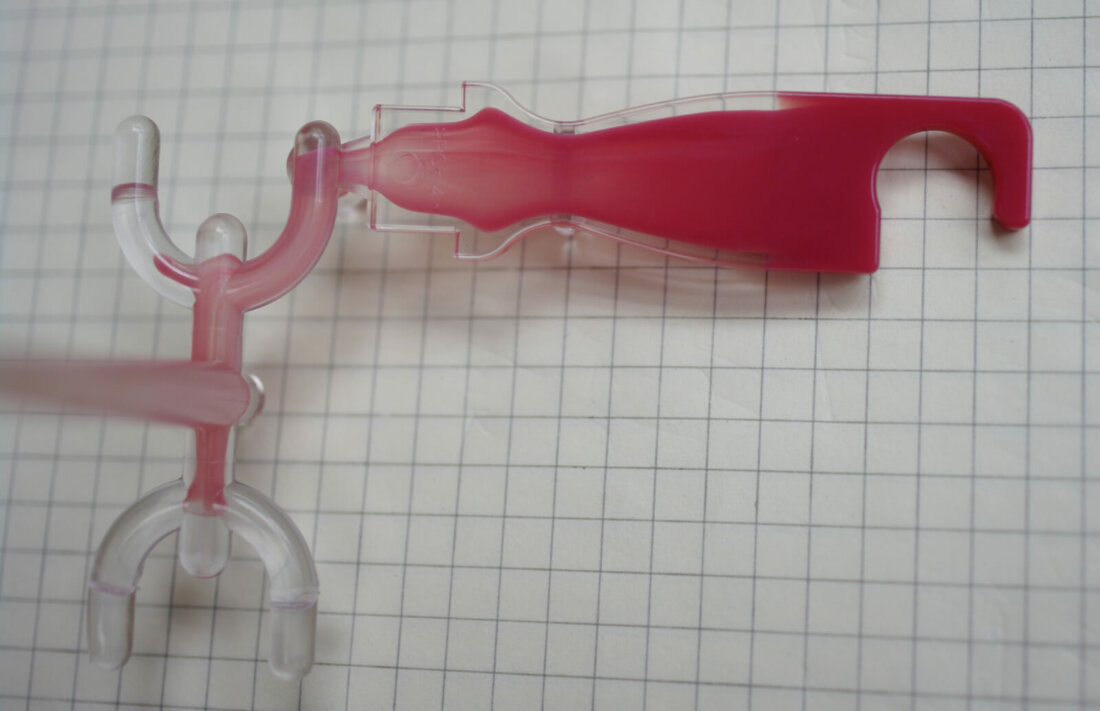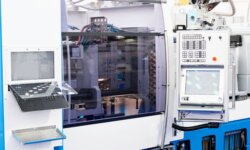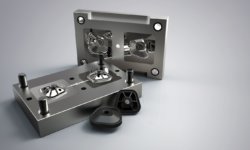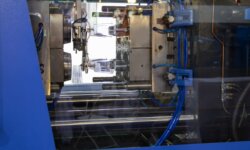Engineers often require different material properties across different regions of a part, and they can achieve this goal in various ways.
Often, parts will be designed as separate components that can be assembled using glue or fasteners. One component of the assembly may be made from a soft, pliable material, while another might be made from a rigid thermoplastic. In the domain of injection molding, another useful technique is overmolding, in which one layer of material is molded over another, resulting in a two-part molding with two different materials or colors.
A different approach to dual-material molding is co-injection molding, which involves injecting two materials into a mold cavity. One material forms the “skin” or outer layer of the molding, while the other forms the internal “core.” Unlike two-shot molding or overmolding, co-injection molding only requires a single mold cavity.
This article goes over the basics of co-injection molding, looking at how the process works, its main advantages and challenges, and some common applications.
What is co-injection molding?
Co-injection molding (sometimes called sandwich molding) is a form of injection molding in which two injection units are deployed to inject two different materials into one mold. When a suitable combination of materials is used, one material forms the outer skin of the molded part, while the other forms the internal core. Making parts from two distinct materials in the same mold opens up a range of possibilities while keeping cycle times relatively short.
The co-injection molding process requires a multi-material injection molding machine or a supplementary injection unit for the second material. The best results are typically achieved using a hot runner system, in which precise metering and temperature control allow for the two materials to be injected into the mold cavity in sequence. However, a cold runner system with a manifold can also be used.
The basic co-injection process goes like this:
- The first injection unit injects the skin material into the mold; material cools and hardens when it reaches the mold walls
- The second injection unit injects the core material into the mold, which pushes the skin material further towards the mold walls; because the materials are immiscible, they do not blend together, instead forming distinct layers
- The first injection unit injects more skin material into the mold (optional), pushing the core material inwards and sealing off the gate area with skin material, creating a sandwich molding
Co-injection molding is very different to two-shot molding or overmolding. While it also uses two different polymers, it only requires a single mold cavity. Neither the mold nor the molding has to be moved in between injections. However, unlike two-shot molding or overmolding, co-injection molding cannot be used to place material in specific, user-selected locations; the “skin” must cover the entire outer surface of the part.
Advantages of co-injection
Engineers may favor co-injection molding for many reasons. For instance, using different materials for the inside and outside of a molding can have significant aesthetic, functional, and cost benefits.
Part performance
One of the most significant benefits of co-injection molding is the wide range of potential engineering possibilities that can lead to improved part performance. There are infinite reasons why an engineer might want to combine two different sets of material properties in a single molded part.
Examples of co-injection leading to improved performance include parts with a foam core (reducing weight, creating buoyancy, or provides acoustic insulation) and parts with a glass-filled core (increasing part strength and stiffness).
Appearance
Co-injection opens up aesthetic possibilities, as the skin can be made from a cosmetically appealing material while the core serves a purely functional purpose. Co-injection also allows for unique effects such as color gradation, which may be useful in the production of eye-catching food packaging, for example.
Cost
In many cases, parts can be made with a high-quality skin material and a low-cost core in order to significantly decrease unit cost. While setup costs for co-injection can be high, these unit cost savings can become significant during high-volume production.
Cycle time
Co-injection molding of two materials is typically faster than overmolding or assembly of two separate components. So while the co-injection process comprises three injection phases, it still offers excellent production efficiency for multi-material parts.
Limitations of co-injection
Co-injection molding is not suitable for all multi-material molding projects. Its main disadvantages include:
- The need for a multi-injection setup, which can be expensive and which requires a fairly high level of expertise to operate
- Not all polymers are suitable for co-injection or mutually compatible; the core material typically needs to be more viscous than the skin material
- Does not allow for selective placement of material regions like two-shot molding or overmolding
Co-injection molding examples
A variety of skin/core combinations can be used during the co-injection molding, depending on the part and its desired qualities. Some examples and co-injection molding applications are listed in the table below.
Skin | Core | Benefit | Application |
Virgin material | Environmental benefits while maintaining aesthetic qualities on part surface | Food packaging | |
Soft material (e.g. TPE) | Hard material (e.g. PP) | Shock-absorbing or ergonomic part exterior | Tool handle |
Dense material | Foam | Lightweight or buoyant part with water-resistant skin | Buoyancy aid |
Injection molding with 3ERP
3ERP has years of experience making injection molded parts and prototypes, with no project too large or too small. Contact us for a free quote on your next project, whether you need single-injection, co-injection, or overmolded parts.








